1.MyBatis简介
MyBatis 是一款优秀的持久层框架,它支持自定义 SQL、存储过程以及高级映射。MyBatis 免除了几乎所有的 JDBC 代码以及设置参数和获取结果集的工作。MyBatis 可以通过简单的 XML 或注解来配置和映射原始类型、接口和 Java POJO(Plain Old Java Objects,普通老式 Java 对象)为数据库中的记录。
2.Mybatis入门使用
1.首先创建一个数据库表用于操作
DROP DATABASE mybatis;
CREATE database mybatis;
use mybatis;
drop table if exists tb_user;
CREATE TABLE tb_user(
id int PRIMARY KEY auto_increment,
username VARCHAR(20),
password VARCHAR(20),
gender char(1),
addr varchar(30)
);
insert into tb_user VALUES (1,'王伟','123','男','北京');
insert into tb_user VALUES (2,'杨晓萌','234','女','天津');
insert into tb_user VALUES (3,'孙冰','11','男','西安');
2.然后需要在maven的xml文件中配置Mybatis依赖
<!--mybatis的依赖-->
<dependency>
<groupId>org.mybatis</groupId>
<artifactId>mybatis</artifactId>
<version>3.5.5</version>
</dependency>3.写mybatis-config.xml配置文件
<?xml version="1.0" encoding="UTF-8" ?>
<!DOCTYPE configuration
PUBLIC "-//mybatis.org//DTD Config 3.0//EN"
"http://mybatis.org/dtd/mybatis-3-config.dtd">
<configuration>
<environments default="development">
<environment id="development">
<transactionManager type="JDBC"/>
<dataSource type="POOLED">
<!--数据库连接信息-->
<property name="driver" value="com.mysql.jdbc.Driver"/>
<property name="url" value="jdbc:mysql://localhost:3306/mybatis?useSSL=false"/>
<property name="username" value="root"/>
<property name="password" value="1234"/>
</dataSource>
</environment>
</environments>
<!--指定sql映射的文件-->
<mappers>
<mapper resource="UserMapper.xml"/>
</mappers>
</configuration>4.写sql映射文件
<?xml version="1.0" encoding="UTF-8" ?>
<!DOCTYPE mapper
PUBLIC "-//mybatis.org//DTD Mapper 3.0//EN"
"http://mybatis.org/dtd/mybatis-3-mapper.dtd">
<!--
namespace 名称空间
-->
<mapper namespace="test">
<!--id是sql语句的唯一标识 resultType对应返回结果的类型-->
<select id="selectAll" resultType="com.yrh.pojo.User">
select * from tb_user;
</select>
</mapper>5.Mybatis测试类Java代码
User类如何实现此处省略
package com.yrh;
import com.yrh.pojo.User;
import org.apache.ibatis.io.Resources;
import org.apache.ibatis.session.SqlSession;
import org.apache.ibatis.session.SqlSessionFactory;
import org.apache.ibatis.session.SqlSessionFactoryBuilder;
import java.io.IOException;
import java.io.InputStream;
import java.util.List;
public class MybatisDemo {
public static void main(String[] args) throws IOException {
//1.加载mybatis的核心配置文件 获取SqlSessionFactory
String resource = "mybatis-config.xml";
InputStream inputStream = Resources.getResourceAsStream(resource);
SqlSessionFactory sqlSessionFactory = new SqlSessionFactoryBuilder().build(inputStream);
//2.获取SqlSession对象,用来执行sql
SqlSession sqlSession = sqlSessionFactory.openSession();
//3.执行sql语句
List<User> users = sqlSession.selectList("test.selectAll");
System.out.println(users);
//4.释放资源
sqlSession.close();
}
}
3.Mapper代理开发(常用)
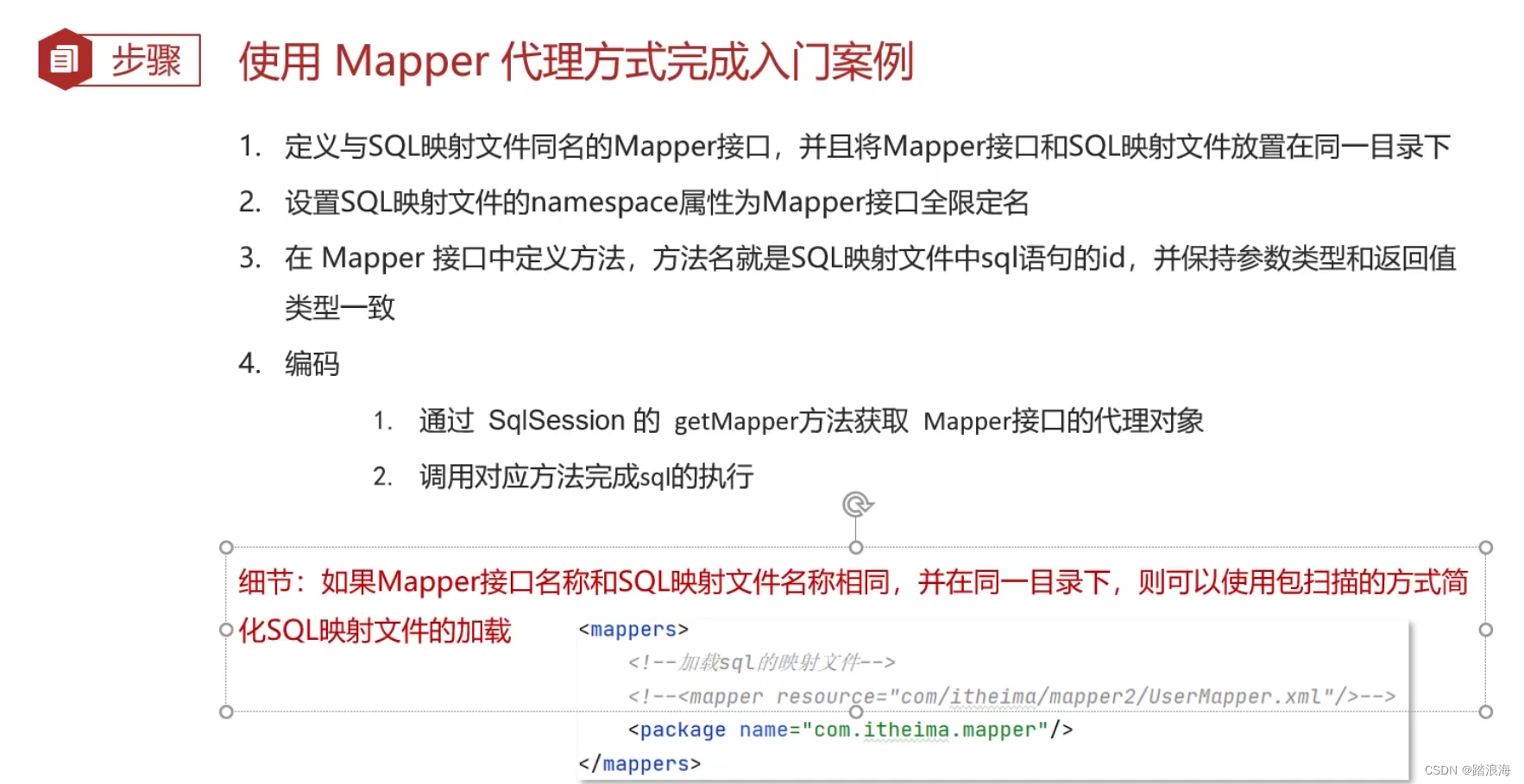
Mybits-config
<!--指定sql映射的文件-->
<mappers>
<!-- <mapper resource="com/yrh/mapper/UserMapper.xml"/>-->
<!-- 包扫描方式-->
<package name="com.yrh.mapper"/>
</mappers>
</configuration>UseMapper.xml
<!--设定为Mapper接口的全限定名-->
<mapper namespace="com.yrh.mapper.UserMapper">
<!--id是sql语句的唯一标识 resultType对应返回结果的类型-->
<select id="selectAll" resultType="com.yrh.pojo.User">
select * from tb_user;
</select>
</mapper>UserMapper.java(接口)
package com.yrh.mapper;
import com.yrh.pojo.User;
import java.util.List;
public interface UserMapper {
List<User> selectAll();
}
Mapper代理开发Java代码
package com.yrh.pojo;
import com.yrh.mapper.UserMapper;
import org.apache.ibatis.io.Resources;
import org.apache.ibatis.session.SqlSession;
import org.apache.ibatis.session.SqlSessionFactory;
import org.apache.ibatis.session.SqlSessionFactoryBuilder;
import java.io.IOException;
import java.io.InputStream;
import java.util.List;
public class MybatisDemo2 {
public static void main(String[] args) throws IOException {
//1.加载mybatis的核心配置文件 获取SqlSessionFactory
String resource = "mybatis-config.xml";
InputStream inputStream = Resources.getResourceAsStream(resource);
SqlSessionFactory sqlSessionFactory = new SqlSessionFactoryBuilder().build(inputStream);
//2.获取SqlSession对象,用来执行sql
SqlSession sqlSession = sqlSessionFactory.openSession();
//3.执行sql语句
//List<User> users = sqlSession.selectList("test.selectAll");
//System.out.println(users);
// 3.1 获取对应的UserMapper接口的代理对象
UserMapper mapper = sqlSession.getMapper(UserMapper.class);
List<User> users = mapper.selectAll();
for (User user : users) {
System.out.println(user);
}
//4.释放资源
sqlSession.close();
}
}
4.使用Mybatis实现数据的增删改查

<mapper namespace="com.yrh.mapper.BrandMapper">
<resultMap id="brandResultMap" type="com.yrh.pojo.Brand">
<!--
id:完成主键字段的映射
column:表的列名
property:实体类的属性名
result:完成一般字段的映射
column:表的列名
property:实体类的属性名
-->
<result column="brand_name" property="brandName"/>
<result column="company_name" property="companyName"/>
</resultMap>
<select id="selectAll" resultMap="brandResultMap">
select * from tb_brand;
</select>
</mapper>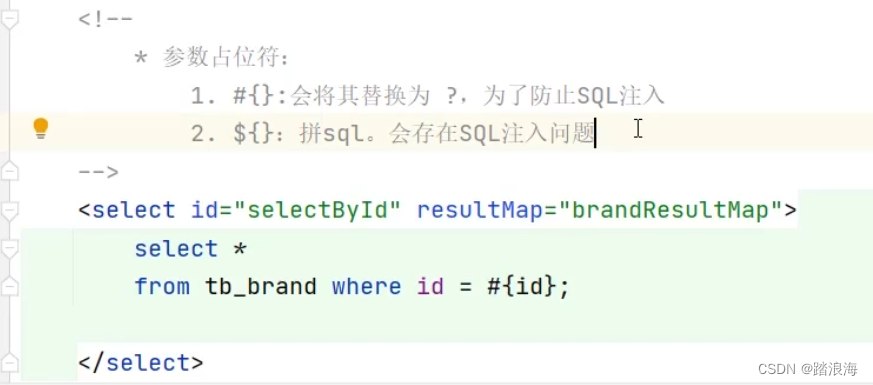
1.查询功能
多条件查询:
<select id="selectByCondition" resultMap="brandResultMap">
select * from tb_brand where status = #{status} and company_name like #{companyName} and brand_name like #{brandName}
</select>List<Brand> selectByCondition(Brand brand); public static void selectbyCondition() throws IOException{
int status = 1;
String companyName = "华为";
String brandName = "华为";
companyName = "%"+companyName+"%";
brandName = "%"+brandName+"%";
Brand brand = new Brand();
brand.setCompanyName(companyName);
brand.setBrandName(brandName);
brand.setStatus(status);
String resource = "mybatis-config.xml";
InputStream inputStream = Resources.getResourceAsStream(resource);
SqlSessionFactory sqlSessionFactory = new SqlSessionFactoryBuilder().build(inputStream);
//2.获取SqlSession对象,用来执行sql
SqlSession sqlSession = sqlSessionFactory.openSession();
//3.执行sql语句
//List<User> users = sqlSession.selectList("test.selectAll");
//System.out.println(users);
// 3.1 获取对应的UserMapper接口的代理对象
BrandMapper mapper = sqlSession.getMapper(BrandMapper.class);
List<Brand> brands = mapper.selectByCondition(brand);
System.out.println(brands);
//4.释放资源
sqlSession.close();
}动态条件查询:dan
<select id="selectByCondition" resultMap="brandResultMap">
select * from tb_brand
<where>
<if test="status!=null">and status = #{status}</if>
<if test="companyName!=null and companyName!=''">
and company_name like #{companyName}
</if>
<if test="brandName!=null and brandName!=''">
and brand_name like #{brandName}
</if>
</where>
</select>单条件动态查询
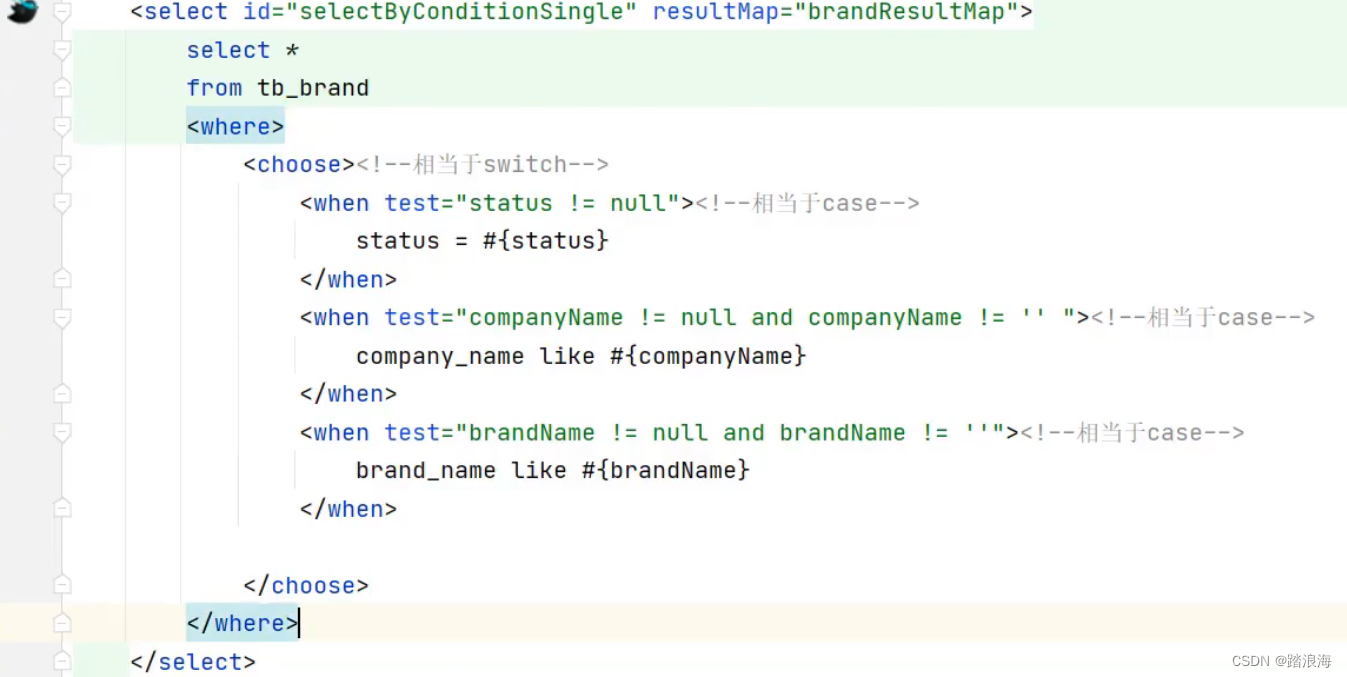
2.添加功能
<insert id="add" useGeneratedKeys="true" keyProperty="id">
insert into tb_brand (brand_name, company_name, ordered, description, status)
values (#{brandName}, #{companyName}, #{ordered}, #{description}, #{status});
</insert>使用修改数据库的功能时需要手动提交事务,也可以设置自动提交
SqlSession sqlSession = sqlSessionFactory.openSession(true);设置主键返回
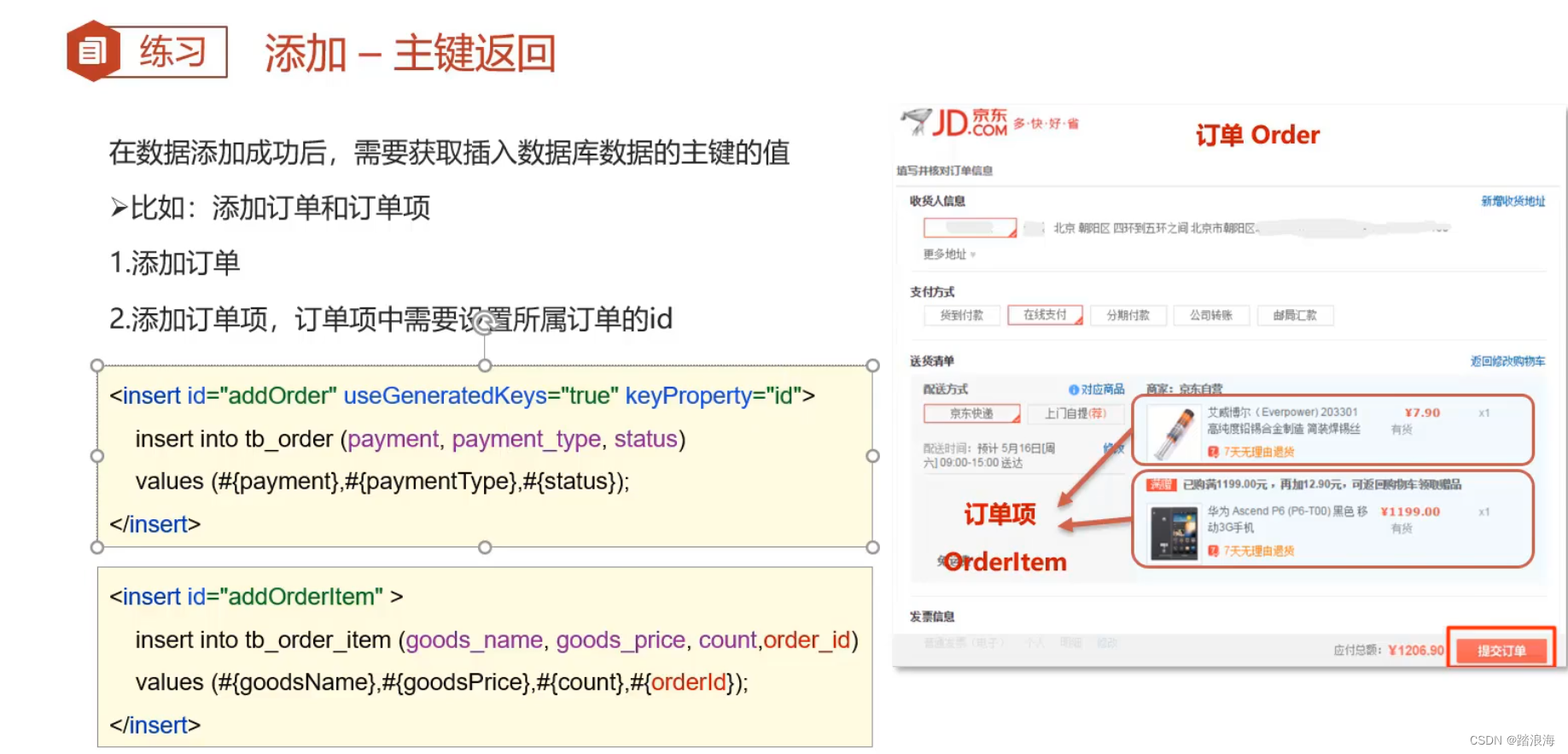
3.修改功能
<update id="update">
update tb_brand
<set>
<if test="brandName != null and brandName != ''">
brand_name = #{brandName},
</if>
<if test="companyName != null and companyName != ''">
company_name = #{companyName},
</if>
<if test="ordered != null">
ordered = #{ordered},
</if>
<if test="description != null and description != ''">
description = #{description},
</if>
<if test="status != null">
status = #{status}
</if>
</set>
where id = #{id};
</update>4.删除功能
/**
* 批量删除
*/
void deleteByIds(int[] ids); <delete id="deleteByIds">
delete from tb_brand where id
in
<foreach collection="array" item="id" separator="," open="(" close=")">
#{id}
</foreach>
;
</delete>5.参数传递

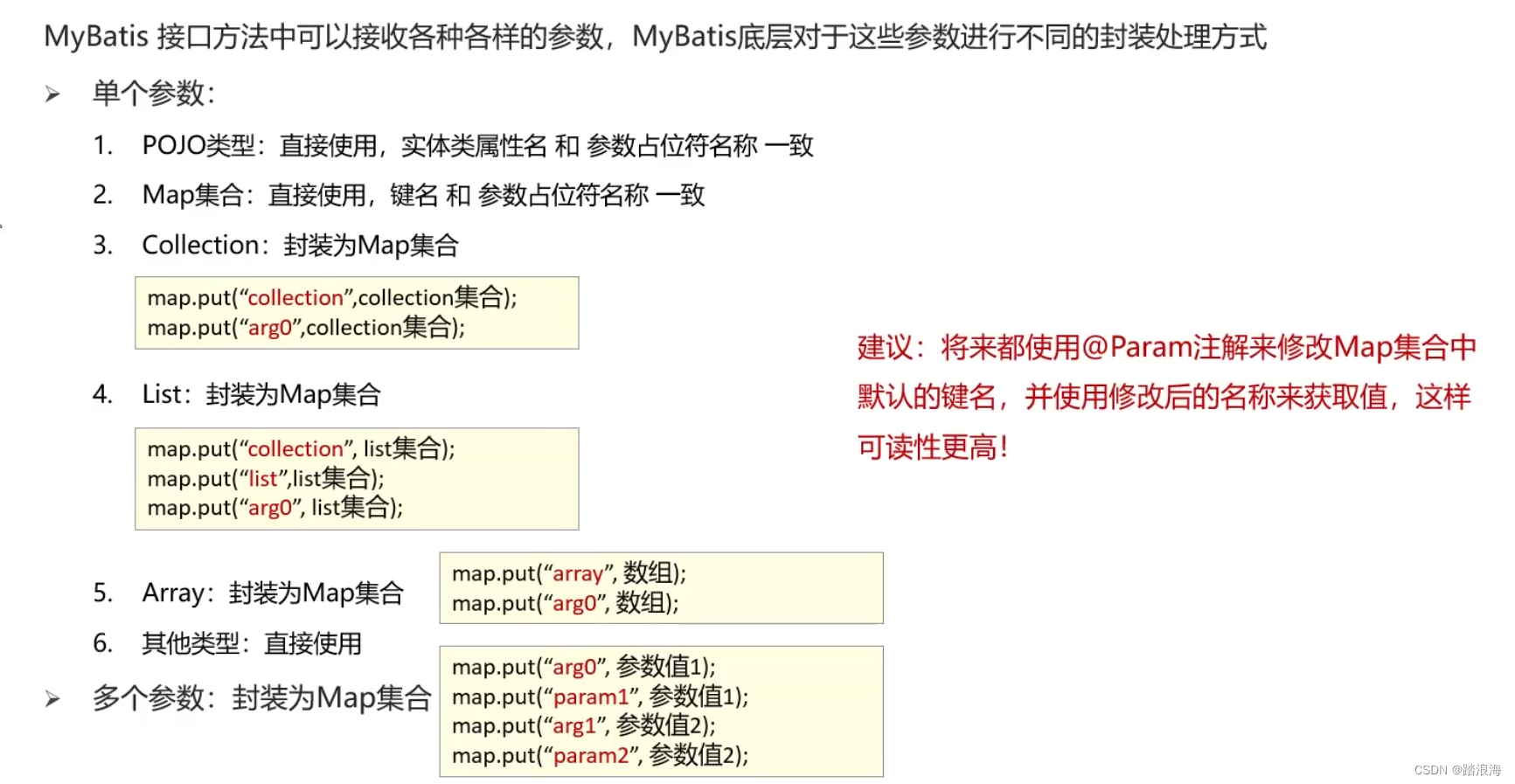
6.使用注解的方式完成增删改查
@Select("select * from tb_user where id = #{id}")
User selectById(int id);






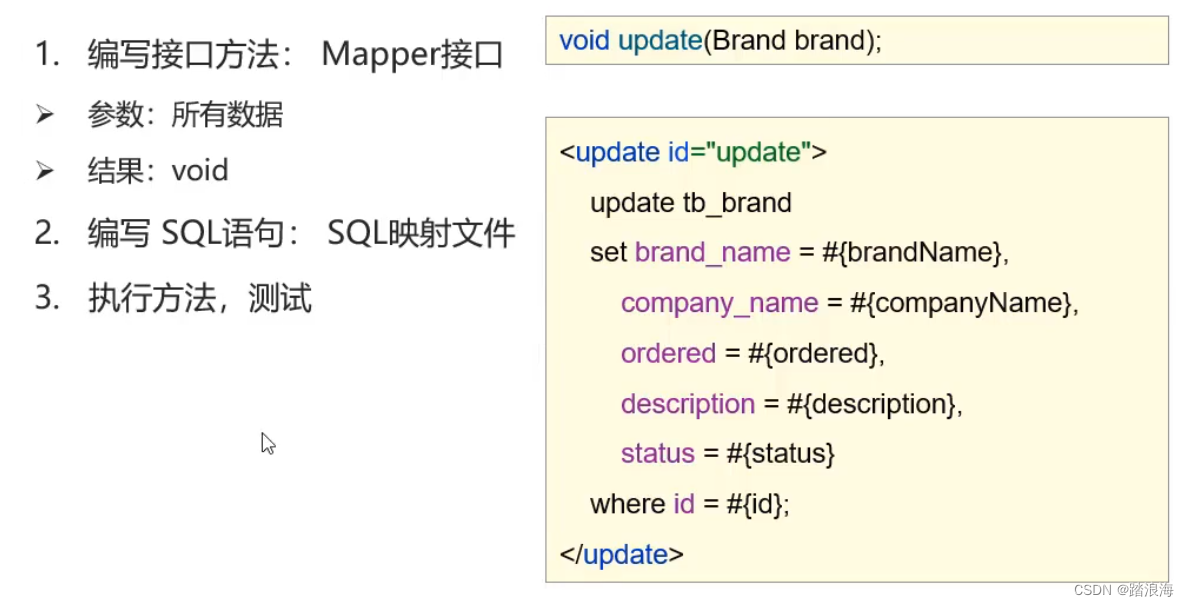
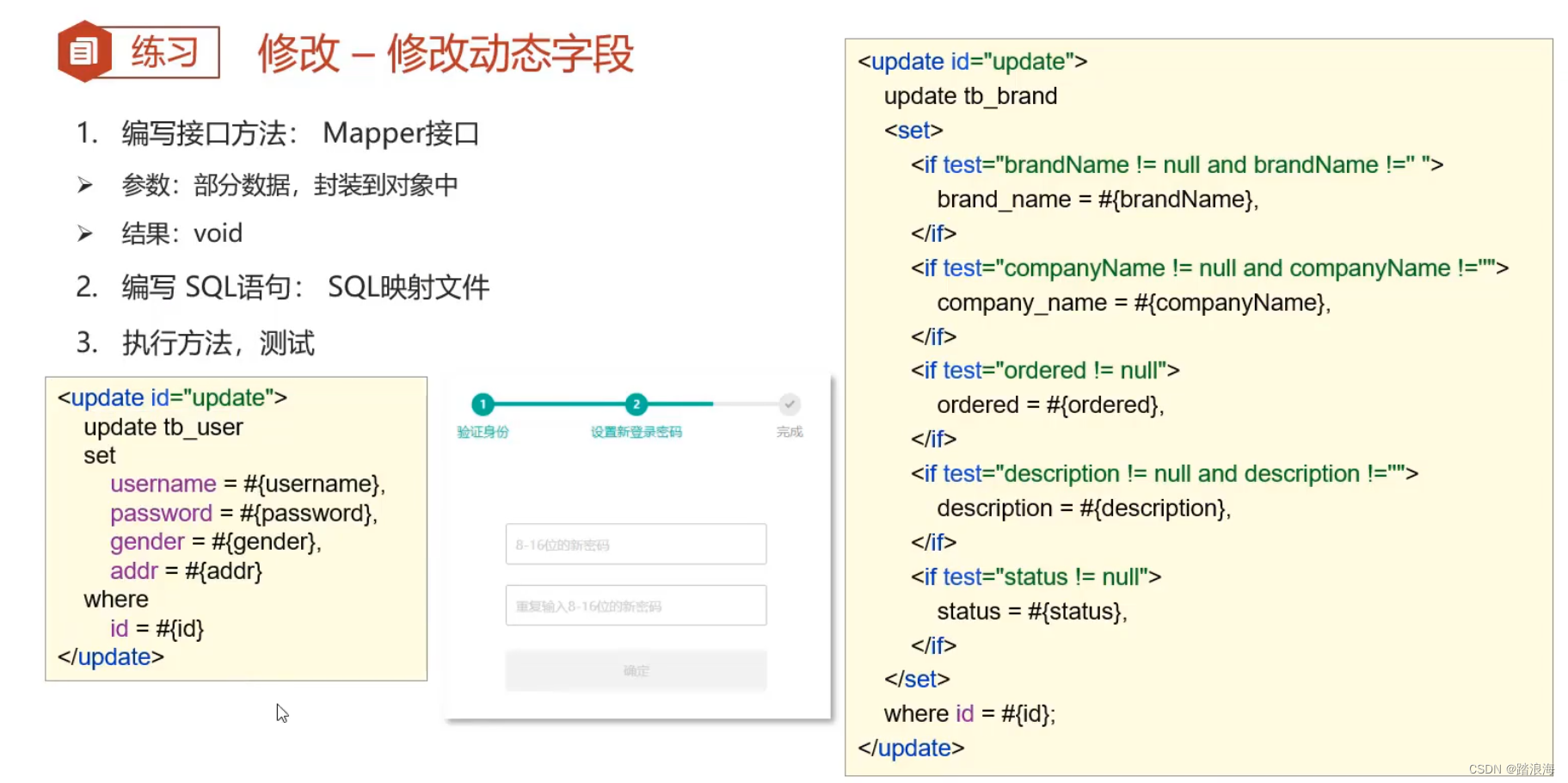














 6478
6478

 被折叠的 条评论
为什么被折叠?
被折叠的 条评论
为什么被折叠?








